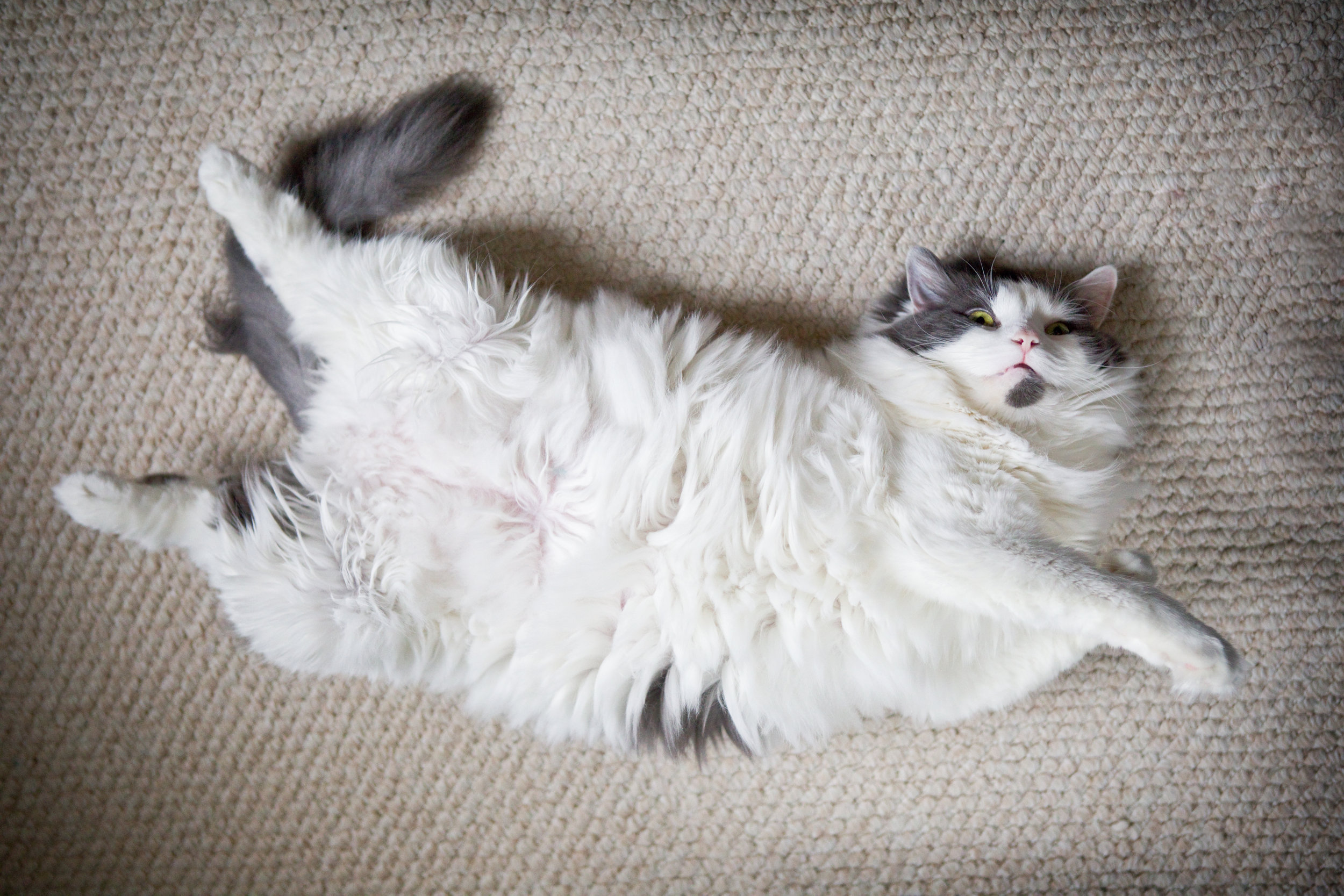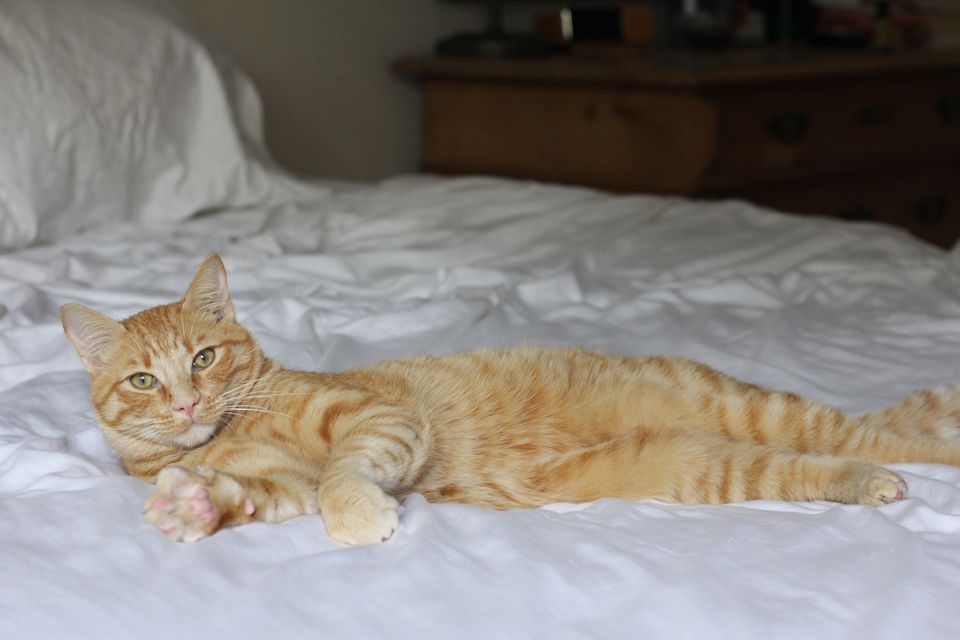- Approximately half of the pets in the United States are either overweight or obese. The health consequences of obesity include increased risk for joint disease, heart and respiratory problems, and diabetes.
- As with humans, weight management is not a quick fix, and the associated goals and lifestyle changes should be long-term in order to be successful.
Why Is Weight Control Important?
Currently, studies estimate that approximately half of the pets in the United States are either overweight or obese. The health consequences of obesity in pets include increased risk for joint disease, heart and respiratory problems, and diabetes. Some researchers also have redefined obesity as a chronic inflammatory condition that can have other harmful effects in the body. Being overweight is not cute and it is not just a nuisance; it is now being recognized as a medical problem that should be managed long-term to reduce associated health risks.
On the positive side, research has shown that keeping dogs lean can increase their lifespans by as much as 2 years. While the same research has not been done in cats, it stands to reason that eliminating the health risks associated with obesity could extend their lives as well.
Why Is Weight Control So Difficult?
Despite the fact that many of us struggle to help our pets lose weight, the formula for weight management is actually rather simple—if calories burned through activity exceed calories taken in through food and treats, weight loss will occur. Unfortunately, this formula can seem difficult to implement for several reasons.
First, many pet owners don’t know the daily calorie requirements for a dog or cat. Even for a conscientious pet owner, it can be difficult to understand pet food labels and realize how many calories a pet is eating. Sometimes (especially when there are several family members who interact with a pet), it can be difficult to know exactly how much and how often your pet is eating. Even if you think your pet may not be eating too much, weight gain can happen so gradually that you are unaware of it until the problem is obvious to an outside observer. Also, sometimes life just gets in the way and things like exercise can slip by the wayside.
How Is Obesity Diagnosed?
Most human physicians use body mass index scales (tables that compare height to weight) to help determine if a patient is overweight. Many veterinarians are now using a relatively standardized system called body condition scoring to help determine if pets are overweight. There is a 5-point scale in which a dog or cat that has a body condition score (BCS) of 3 is at the ideal weight, a score of 1 to 2 indicates the pet is underweight, and pets with a score between 4 and 5 are overweight or obese. There is also a similar 9-point scale in which a score of 4 to 5 is considered ideal weight, 1 to 3 is underweight, and 6 to 9 is overweight or obese.
If your pet’s BCS is not ideal, your veterinarian may begin the discussion with you by asking what your pet eats each day and how much exercise he or she gets. Some pet owners are surprised when they add up how much food, treats, and table scraps a pet may consume in a day. Your veterinarian may also want to discuss diagnostic testing to investigate any medical problems, such as thyroid disease, that can affect a pet’s body weight.
How Can I Tip the Scale in My Pet’s Favor?
Once you and your veterinarian determine that your pet has a weight problem, and underlying medical concerns have been addressed, the next steps involve deciding how to correct the problem. As with humans, weight management is not a quick fix; the associated goals and lifestyle changes should be long-term in order to be successful. Here are some tips that can help get weight loss started and keep it going:
- Pick reasonable weight loss goals: Your veterinarian can help you determine how many calories your pet needs each day, and how many pounds your pet needs to lose. Once this information is understood, your veterinarian can work with you to develop a healthy, reasonable schedule for meeting specific weight loss goals.
- Start with a plan that is going to work for you and your pet: Your veterinarian may recommend increased activity (such as leash walks, swimming, or other exercise) along with dietary modifications to help your pet lose weight. Talk frankly with your veterinarian about how much time and effort you can commit to your pet’s weight loss program. If leash walks are not possible, or you can’t change your pet’s diet, ask about other options. If your pet has joint problems, like osteoarthritis, you may need to address joint pain before your pet is willing to become more active. You and your veterinarian need to work together to find the best weight management solutions. There are generally many ways to approach weight loss—there is even a “diet pill” formulated for dogs to help them lose weight. However, there is no diet pill for cats, and exercise can be a particular challenge for indoor cats. Talk to your veterinarian about ways to increase activity that will work for you and your pet.
- Commit to your pet: This can be challenging because it means understanding that your pet’s obesity is a problem that you need to commit to solving without making yourself feel guilty. Perhaps some mistakes were made, but having an overweight pet does not mean you are a bad person. So start the process by giving yourself a break. Pointing fingers does not solve the problem—try to focus instead on what is going to happen from today forward!
- Measure: Measure the amount of food you are feeding your pet each day. If you don’t know how much you are feeding, there is no way to know how many calories your pet is eating. Don’t forget to check the number of calories in treats, as these can also add up on a daily basis. If you must give treats, consider low-calorie alternatives, like raw carrots, green beans, or air-popped popcorn for dogs.
- Learn how to overcome barriers to success: Barriers to success include giving treats or extra food, letting the overweight or obese pet have access to another pet’s food, or feeling guilty and giving in when your pet begs for food. Other barriers are exhibited by the pets themselves and include refusal to eat a diet food or to exercise. Inability to overcome these barriers on a daily basis will doom any weight loss program to failure. Talk to your veterinarian about ways to overcome them.
- Understand the importance of this lifestyle change:Being overweight increases the risk of certain medical conditions and can shorten your pet’s life. It may be difficult to withhold treats and table food from a pet that is used to getting them, but before you give in, think about the big picture! If you want your pet to be healthy and to live a longer life, weight management needs to be part of that plan.
- Make monitoring fun: Your veterinarian may recommend seeing your pet for periodic weight checks to keep track of how your weight management program is progressing. Try to make this as much fun as possible. Consider scheduling an extra trip to the park for a walk after each weigh-in. Or take a trip to a pet store for a new toy after key weight loss goals are achieved. Some veterinarians offer programs to help encourage you through the weight loss process, like posting “before” and “after” photos of pets. This can give your self-esteem a boost, as well as encourage another pet owner who may still be struggling with his or her pet’s weight problem.














